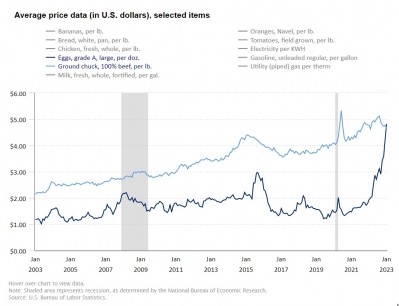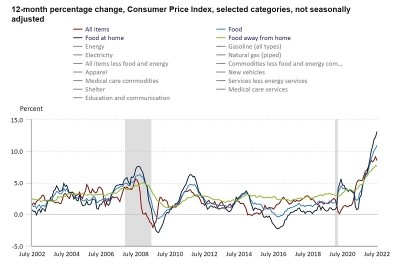Soaring butter prices put dairy market and retail prices under pressure, report finds

The latest Consumer Price Index (CPI) issued by the Bureau of Labor Statistics for the month of May 2022 shows food at home prices up 11.9% vs. one year ago and up 1.4% from April 2022. The index for dairy and related products rose by 2.9% in May 2022 vs. the previous month, the largest monthly increase since July 2007.
According to CoBank's market analysis which included CPI tracking from January 2020 through March 2020, butter prices have soared even higher than any other food or other consumer product category at 16% YoY (in March 2020) vs. 8.2% YoY for all products.
"With ongoing butter shortages, historically high butter prices are all but certain to continue for the remainder of 2022," Tanner Ehmke, CoBank lead economoist, dairy and specialty crops, noted in his report.
'It’s a problem in the long run'
Prices for butter traded on the CME (Chicago Mercantile Exchange) have risen 27.3% year-to-date, lifting prices for Class IV milk (which is used for butter and powder) above prices for Class III (for cheese and whey) and setting new record high prices paid to farmers.
"While high butter and milk prices are good news in the short term for producers, it’s a problem in the long run. Consumers may be forced to shift to lower-cost store brands, or to butter alternatives like margarine, shortening, and vegetable oils as they face a double whammy of high butter prices right as inflation has muted their spending power. Demand could also deteriorate as consumers buy smaller quantities," Ehmke said.
Compounded the issue of rising prices for dairy and related goods, is that while butter supplies have tightened, butterfat production in the US is at an all-time high.
According to CoBank, US butterfat production totaled 7.28bn lbs in 2011. In 2021, butterfat production reached 9.07bn lbs.
"Changes in cow genetics, dairy cow rations, and herd management have successfully promoted production of butterfat and protein. However, this doesn’t make up for rising demand for higher-fat dairy products, including butter," noted Ehmke.
So why is butter in short supply? According to Ehmke, while farmers may be receiving a premium price for their milk supply, increased costs to feed, energy, labor, and other areas farm production have squeezed their operations and production output.
"Some churns are slowing production due to tight US milk supplies and short staffing at plants. US milk production in April totaled 19.15 billion pounds, down 1% YoY," he said, adding that some butter plants have reported outputs are down 15%-20% due to shortages in staffing.
Outside of butter supply issue, cheese could be dealing with its own set of issues in the short term, said Ehmke, as Class IV milk is now priced well above Class III milk, squeezing cheese processors' bottom line and resulting in slower cheese product.
"At current price levels, cheese makers will not want to build excess inventories for the months ahead, which will make more milk available for butter churns," said Ehmke.
Increased demand for cream and premium dairy
Shifting consumer preference is also impacting the state of the dairy market.
"The demand for fluid milk, particularly skim milk, has further declined as consumers eat more milk equivalents per day in the form of cheese and other dairy products," noted Ehmke.
The continued demand shift from fluid milk to cheese and other high-fat dairy products has therefore increased competition for available butterfat, furthers straining supplies, according to Ehmke.
"Consumers are also seeking premium fluid milk products, such as organic, lactose-free, A2, or filtered milk, or trading up milkfat levels from skim to 2% or whole milk," he added.
Current butter supply
According to Ehmke, butter inventories in cold storage in the US are down by 23.2% this year compared to 2021 with concerns mounting for having enough butter supplies for the rest of the year when demand peaks during the holiday season.
The possibility for rebuilding butter inventories is unlikely, added Ehmke, as the peak butter production season has come to an end and consumers have already started to practice cost-saving behavior when shopping.
"Ultimately, retailers like Walmart have already noted greater price consciousness among grocery customers who are trading down from brands to cheaper private labels, and reducing volumes of purchases, including butter," he said.

















